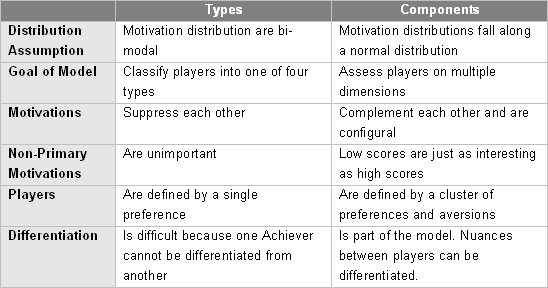Types vs. Components
While there are taxonomical differences between Bartle's Type and the Components mentioned in this presentation (i.e., Socializing and Role-Playing are not highly-correlated), I would argue that there are more important underlying theoretical differences in terms of how the two models conceptualize player motivations. I describe these differences in detail here.
People Don't Fit in Boxes
It only makes sense to have a Type called an Achiever if your population shows a bi-modal distribution of high Achievers and low Achievers. The following graph shows a hypothetical bi-modal distribution.

The problem is that bi-modal distributions seldom occur in personality, attitude or ability assessments. Almost all psychometric assessments follow a normal distribution (the bell curve). For example, the graph below is the histogram of the scores on the Achievement Component in the current data set of 3200 respondents. In other words, most people fall along the mean and there are few individuals who fall along the ends of the spectrum. It only makes sense to classify people into Types when there are clear distinctions in the distribution of the population. This is not the case with player motivations.

Note that Bartle's model doesn't propose an Achievement axis, but the same argument applies to the two underlying axes in his model. The 4 quadrants in his model only makes sense if most people do not all fall near the origin. Bartle's model is a classification model. A player fits in 1 of 4 boxes. The Components model is an assessment model. Every player has a score on each of the components.
====
Motivations Do Not Suppress Each Other
Bartle argues that players have a primary motivation and typically fall clearly into one of the 4 Types. The 2 underlying axes of his model suggest that an Achiever cannot be a Socializer. More importantly, this assumes that motivations suppress each other. The more of an Achiever you are, the less of a Socializer (or Explorer or Killer) you can be.
If this were the case, then we would expect that the 3 main components (Achievement, Social and Immersion) to be highly negatively correlated. In other words, if you score high on Achievement, then you should score low on the Social component (and Immersion component). This is not the case. The 3 main components are largely uncorrelated (r's ~ .10). The following scatterplot with the Achievement and Social components show that motivations are largely independent of each other rather than following an inverse pattern. Your score in Achievement has nothing to do with your score in the Social component.

====
It's Configural
Bartle's Types puts people in one of 4 boxes and argues that the other 3 boxes say nothing about you. The Components model says the opposite. Your scores on all the components matter. A player who scores high on Achievement and low on Socializing (solo grinder) is a very different kind of player from a player who scores high on Achievement and high on Socializing (raid guild officer) and the more you know about their scores, the more you know about their preferences.
More importantly, the Components model shows that low scores are just as interesting as high scores. When you score low on Socializing, it's not the case we simply discard the Socializing component and say it doesn't matter to you. Your low score on Socializing means you don't like games that force you to interact with other people (i.e., dependencies in EQ - bindings, teleports, rezzes). In other words, low scores are just as revealing as high scores.
The key point is that the components are configural. People do not fall into simplistic Types. There are many different kinds of people with high scores on Achievement, and knowing what their other scores are is meaningful. In Bartle's model, all Achievers are the same. In fact, this shortcoming in the Types model is why it became necessary for Bartle to create 4 additional Types (8 Types altogether) in his recent book in an attempt to cover those nuances. The problem is that subdivision is not the answer. People are never just one thing. The answer is not subdivision but understanding that people don't fit into boxes. Motivations are configural. If it's ok for me to like both ice-cream and French onion soup in real life at the same time, why can't I be both an Achiever and Socializer in an MMORPG at the same time? Players can never be understood if they are assumed to be defined by a single preference. Players are multi-faceted and most people like and dislike many things at the same time. The core problem with the Types mode is that it says that people can only like one thing at a time.
====
Summary
